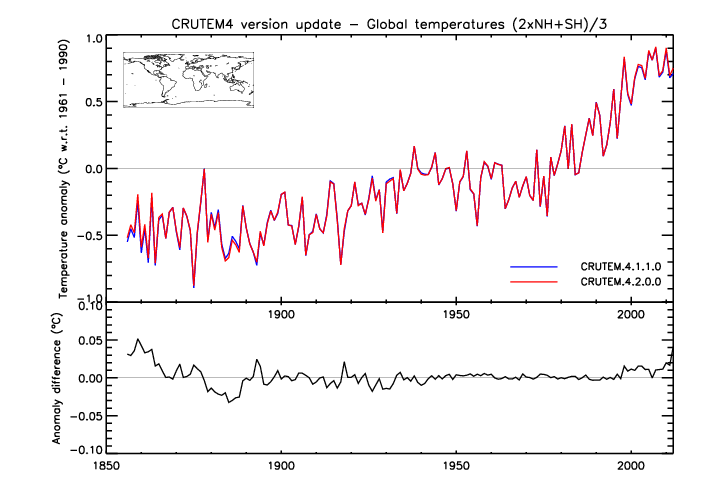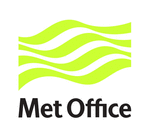
| Met Office Hadley Centre observations datasets |
| > Home > CRUTEM4 > Versions > |
This page describes updates in CRUTEM4 version CRUTEM.4.2.0.0. Previous versions of CRUTEM4 can be found here. Data for CRUTEM.4.2.0.0 can be found here.
The changes listed below refer mainly to additions of mostly national collections of digitized and/or homogenized monthly station series. Several national meteorological agencies now produce/maintain significant subsets of climate series that are homogenized for the purposes of climate studies. In addition, data-rescue types of activities continue and this frequently involves the digitization of paper records which then become publicly available.
The principal subsets of station series processed and merged with CRUTEM (chronological order) are:
In addition, there have been some corrections of errors. These are mostly of a random nature and the corrections have generally been done by manual edits. For a listing of new source codes in use, see below (end).
The Norwegian Meteorological Institute (NMI) has produced a climate database portal. From this facility, more than 230 station series were downloaded for the whole of Norway (including remote islands). After processing and other checks (this included the changing of a few CRUTEM ID codes [see below]), a subset of 181 monthly temperature series was merged with CRUTEM. Before merger (using blanket overwrite), there were 5696 series. 132 new series were added. The changes to ID codes are:
The ACORN-SAT database (holding 112 homogenized daily Tmax and Tmin temperature series) was acquired through Blair Trewin (BoM). The dataset is available for download and a link to this is:
http://datahub.io/dataset/acorn-sat
The start date for the series is 1910 and domestic ID codes are used throughout. This requires a matching exercise with the existing CRUTEM database so that WMO/pseudo-WMO identifiers are in use after initial processing to obtain Tmean series for subsequent merger (using blanket overwrite) with CRUTEM. Five new series were added. It should be noted that the merger with existing CRUTEM holdings does not remove any pre-ACORN subsets already present.
Where pre-ACORN subsets are present after merger, it is necessary to check for any obvious homogeneity issues in the post-merger series. Following the checking exercise, two options are available to address homogeneity issues. One option is the application of 'adjacent' ACORN monthly adjustments to pre-ACORN subsets. The other option is to adjust the first-reliable-year (FRY) header flags so that any data before the FRY are not used in CRUTEM analyses. 22 of the post-merger series had adjustments applied to the pre-ACORN subset and 17 of the post-merger series retained/acquired FRY flags that are different from their first year of data.
A significant subset of Brazilian series has been made available to the International Surface Temperature Initiative (ISTI - see http://www.surfacetemperatures.org/ ) by Waldenio Almeida.
The Stage2 daily repository (ftp://ftp.ncdc.noaa.gov/pub/data/globaldatabank/daily/stage2/) holds the Brazilian subset and from here, 289 series were downloaded for processing into monthly CRUTEM format. There were 44 matches during a trial merger with CRUTEM. However, the differences matrices generated during the merger provided evidence to suggest that the existing CRUTEM monthly Tmean values may be generated using a different formula to that used in the current exercise (Tmean=[Tmax+Tmin]/2). Enquiries showed this to be the case. Due to a lack the appropriate sub-daily data with which to reproduce the Tmean values, this ruled out the inclusion of the 44 matching series (or any component thereof) in CRUTEM.
Only new series were therefore involved in the final merger with CRUTEM. These were then filtered to remove those series too short to be of any current use for gridding purposes. Finally, 183 new Brazilian series were incorporated into CRUTEM.
Eight series for Austalian remote islands were provided by Blair Trewin (BoM). After processing, a merger was undertaken (by blanket overwrite). Only minor amendment of a small number of values was apparent - no new series were added.
Having downloaded Southern-Hemisphere station series for the greater Antarctic from the British Antarctic Survey web pages (BAS) - see, for example: http://www.antarctica.ac.uk/met/READER/ it was possible to compare monthly values between CRUTEM series and their BAS counterparts. A trial merger of the downloaded series with CRUTEM was taken as a QC exercise. Larger discrepancies on monthly values within common blocks were checked out. In general, BAS files were found to have less errors than their CRUTEM counterparts but this was not exclusively so. All 'erroneous' values were replaced by their opposite counterpart. A degree of infilling of previously missing values was achieved in the final merger.
In addition, while the above exercise was confined to terrestrial manned station series, the land series for BYRD (89125) that ends in the 1970s had the automated weather station (AWS series 89324) appended from 1980. This was after a degree of checking for compatibility of the new with the old. The combined series has had its CRUTEM ID changed to 89324.
This series (61901) became the focus of a homogeneity check. Data antecedents were checked and it was found that no adjustment had taken place after a known elevation change during the 1970s. A standard lapse rate adjustment (for the elevation difference) was made to the pre-1977 subset.
After personal contact with climate scientist in Bolivia (Marcos Andrade, umd.edu), eight temperature series were received. Seven of the eight were new to CRUTEM. All series were merged.
A large subset (170+ series) of daily temperature series (Tmax and Tmin) were downloaded from the SACA download facility at http://saca-bmkg.knmi.nl/rcc/dailydata/predefinedseries.php . This joint KNMI/Indonesian initiative holds a number of Australian series (northern Australia and offshore locations) in addition to those from Papua New Guinea, Malaysia, Thailand, Philippines, Micronesia and Western Samoa. An extensive WMO/CRUTEM ID code matching exercise was called for due to the use of internal ID codes by SACA. Due to the very incomplete nature of many of the series and the overlap of Australian series with the ACORN subset (see above), a lot of filtering out of possible series for merger was undertaken.
A subset of 54 series was eventually merged with CRUTEM. 50 of these series are new to CRUTEM (mostly Australian). The merger was set to infill missing values only and the SACA series are not homogenized.
Further use was made of the ISTI Stage2 holdings (see 3, above). This time, the monthly repository was used: ftp://ftp.ncdc.noaa.gov/pub/data/globaldatabank/monthly/stage2/. The series downloaded (99 German and 7 Polish) are raw - non-homogenized. The processing exercise required a CRUTEM/WMO ID matching exercise for the German subset. In a trial merger with CRUTEM, it was found that there was some overlap with series that had previously been subjected to homogenization exercises (GHCN and HISTALP initiatives). This required the filtering out of the previously homogenized series - before merger.
The final merger with CRUTEM involved 91 series and 58 new series were added. A fair degree of infilling and extension of existing series was achieved.
A subset of Ugandan daily temperature series, compiled by John Christy (University of Alabama in Huntsville) and made publicly available via the ISTI Stage2 repository (see: ftp://ftp.ncdc.noaa.gov/pub/data/globaldatabank/monthly/stage2/east-africa/ ) was downloaded. Due to the relative brevity of many of the series, only nine series were eventually processed into CRUTEM format and merged with CRUTEM. Seven of the nine are new to CRUTEM. To enable a merger with the series for Kampala (CRUTEM ID 737067), the ID code was changed to 63630(0).
The USHCNv2.5 dataset (http://www.ncdc.noaa.gov/oa/climate/research/ushcn/ ) is available for download. The homogeneity-adjusted version files contain information and data for 1218 series in the US. As with many such initiatives, the ID codes are domestic and for use in CRUTEM, it is necessary to match these with existing CRUTEM series to obtain WMO or pseudo-WMO ID codes as used in CRUTEM. 1059 of the 1218 series were matched via their local ID codes in existing CRUTEM headers after processing to monthly series. This left 159 series that needed matching with WMO or pseudo-WMO codes. This second matching exercise used distance and other station details from the pool of past and present CRUTEM ID codes that are not already in use after the primary matching exercise (above). Any unmatched series were given new pseudo-WMO ID codes.
The merger (blanket overwrite) with CRUTEM was conducted in two stages. The first merger added the 1059 series (none being new to CRUTEM) and the second stage added 159 series (94 new series). It was noted that some significant adjustments are present when common blocks are compared within the mergers (matrices of differences). This means that many previously homogenized series have been reworked (rehomogenized) from their raw origins.
At this point, it was suspected that there could be cases of duplicate US series in CRUTEM - under different ID codes and possibly names. After an exercise that looked at distance-apart and other station details, 52 duplicate series (not necessarily having the same length) were identified and removed from the archive.
Finally, in an exercise that repeats the homogeneity testing of series (described above for the Australian ACORN series) that come out of the merger process having data from the period pre-USHCNv2, a few changes to FRY flags were made:
The latest homogenized climate series are available from:http://www.ec.gc.ca/dccha-ahccd/default.asp?lang=En&n=B1F8423A-1. The monthly means of 338 homogenized climate series have been received through personal contact with Dr Lucie Vincent (Environment Canada). While this is the same number of series (and essentially the same series) received in the 2012 update, there have been some changes. The local ID codes of 12 series have been changed and some of the compound series have been wholly or partially reworked with regard to the component stations/periods used and thus the homogeneity adjustments made. Through all this, there are some changed station header details but no new CRUTEM ID codes.
The following diagnostic plots show comparisons of global and hemispheric time series for CRUTEM.4.2.0.0 and CRUTEM.4.1.1.0.
The following diagnostic plots show comparisons of regional average time series for CRUTEM.4.2.0.0 and CRUTEM.4.1.1.0.
Commercial and media enquiriesYou can access the Met Office Customer Centre, any time of the day or night by phone, fax or e-mail. Trained staff will help you find the information or products that are right for you. |
 |
Maintained by: Colin Morice |
© Crown Copyright |